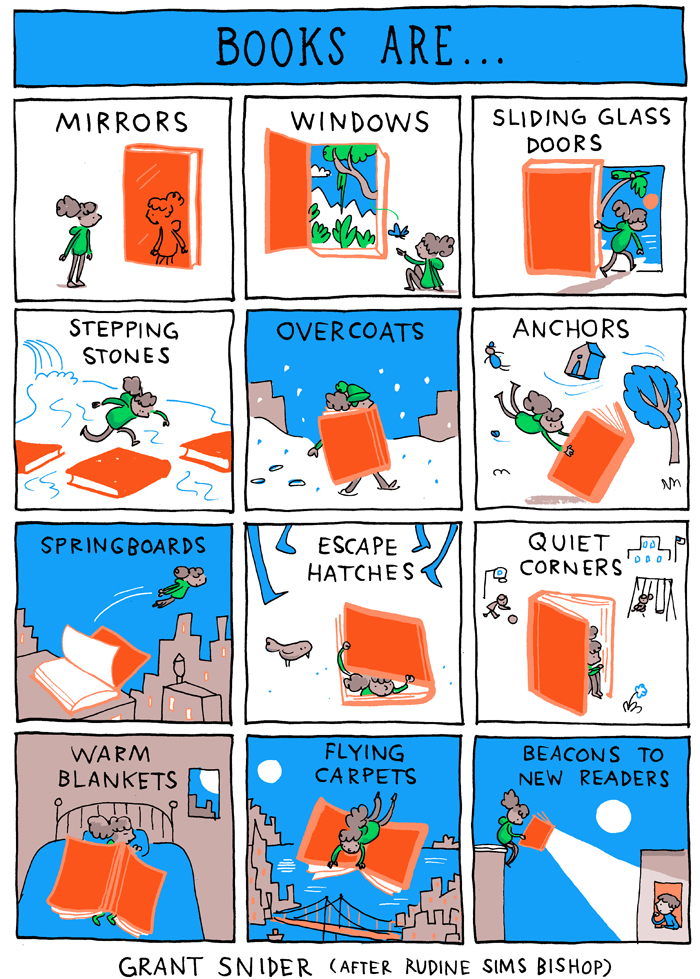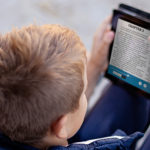by Katy Tessman, New School Services Project Manager at Mackin
Building a diverse collection of fiction, nonfiction, novels in verse, graphic novels, and biographies can be an overwhelming task. The books need to appeal to a wide variety of students that turn over every few years. Knowing how to spend your budget can be quite daunting.
Having diverse literature available helps to create a culture of understanding of each other, and provides powerful tools for teaching students about social justice.1 The need for diverse books extends beyond the school library; English and civics classrooms need access to a variety of texts to go beyond the single story and celebrate cultural diversity.
Windows, Mirrors, Sliding Glass Doors and Beyond
The phrase “windows and mirrors” has been used by educators, especially when it comes to literacy, for quite some time now. This concept was initially introduced by educator Emily Style in 1988 for the National SEED Project. She explained that books that provide windows offer a view into reality, not just into imaginary worlds, and books that reflect a reader’s own life are mirrors.2 In 1990, author/educator Rudine Sims Bishop added to this concept, describing books as sliding glass doors. These doors allow readers to walk into a story and become part of the world that has been created by the author.3 More and more young adult and children’s literature are offering diverse windows into other people’s cultures and varied mirrors into individuals’ experiences.
Finding yourself reflected in a book is powerful. When students read books where they see characters like themselves, their family, and their culture being valued in the world, they feel a sense of belonging. Through access to window texts, students learn to understand and appreciate others.
Books, however, are so much more than windows, mirrors, and sliding glass doors. Grant Snider’s comic in the 2018 issue of The Southampton Review perfectly captures the spirit of what books are.4
Books are anchors during life’s biggest storms; they are escape hatches when the world is too much to take; they are springboards to new ideas and understandings. Books are warm blankets and can save readers from the feelings of loneliness and heartache when they see themselves in literature. As students are discovering their place in the world, the books we provide them act as a guide in this discovery.
Single Story = Stereotypes
Stereotypes can be reflected in literature through the single story. When we are exposed to the single story, showing that people are one way (over and over again) it limits our understanding of who people truly are.
In a 2014 TED Talk, author Chimamanda Ngozi Adichie describes the problem of the single story. She explains, “The single story creates stereotypes, and the problem with stereotypes is not that they are untrue, but that they are incomplete. They make one story become the only story.” Adichie points out, we must seek diverse perspectives and, in turn, writers must tell their own stories. “Telling the stories that only we can tell, about our experiences, hopes, and fears, helps break down the power of cliches and stereotypes.”5
We Need Diverse Books / #OwnVoices
When we say students need diverse books, we are saying that they need books that reflect their own experience as well as the experiences of others. In addition to stories about different races and cultures, diverse books are about gender identity and sexual orientation, people who live in blended families, and people who live in poverty. The diversity provided through window and mirror texts extends beyond ethnicity. Diversity includes how a piece of literature addresses family structures, dialects, cultural traditions and values.6
We Need Diverse Books is an organization created to “advocate changes in the publishing industry to produce and promote literature that reflects and honors the lives of all young people.” #OwnVoices is a movement originally started by YA author Corinne Duyvis on Twitter in 2015. It continues to grow with publishing companies featuring authors who provide an authentic voice. Books with diverse characters are have more value when written by authors from the same diverse group.
Understanding the Human Experience
We are lucky to be educators during a time when a wider variety of authors are sharing their stories. Grace Lin, Matt de la Pena, Jason Reynolds, and Randa Abdel-Fattah, among others, have shared how they want to provide windows, mirrors, and sliding glass doors for children and young adults. Introducing readers to diverse histories and traditions celebrates both our differences and our similarities.
As Margarita Engle, award-winning author said, “Children are the only possible peacemakers of the future.”7 As educators, we have the opportunity to fill our libraries and classrooms with authentic diverse books. These books can be the tools to equip children to become peacemakers. Whether you’re an elementary teacher reading aloud to the class or a high school teacher assigning a social justice project — building a diverse collection is a worthwhile investment. Diverse books allow students to learn from other people’s experiences. Authentic literature is at the heart of students’ understanding of the human experience.
References
1 Everett, C. (n.d.). Windows and Mirrors: Why We Need Diverse Books. [online] Scholastic Book Fairs. Available at http://www.scholastic.com/bookfairs/readerleader/windows-and-mirrors-why-we-need-diverse-books.
2 Style, E. (1988). Curriculum as Window and Mirror. [online] Nationalseedproject.org. Available at: https://nationalseedproject.org/curriculum-as-window-and-mirror.
3 Bishop, R. (1990). “Mirrors, Windows, and Sliding Glass Doors.” Ohio State University. Perspectives: Choosing and Using Books for the Classroom, 6(3).
4 Snider, G. (2018). Books Are…. [online] IncidentalComics.com. Available at: http://www.incidentalcomics.com/2018/06/books-are.html.(printed with permission)
5 Adichie, C. (2009). The Danger of a Single Story. [online] Ted.com. Available at: https://www.ted.com/talks/chimamanda_adichie_the_danger_of_a_single_story.
6 Moran, K. (2018). What Are Mirrors and Windows? [online] WeAreTeachers.com. Available at: https://www.weareteachers.com/mirrors-and-windows/.
7 Krok, L . (2018). ALSC Charlemae Rollins President’s Program: Considering All Children: A New Ideal in Evaluating and Engaging Around Books for Youth. [online] AmericanLibrariesMagazine.org. Available at: https://americanlibrariesmagazine.org/blogs/the-scoop/alsc-charlemae-rollins-presidents-program/.







